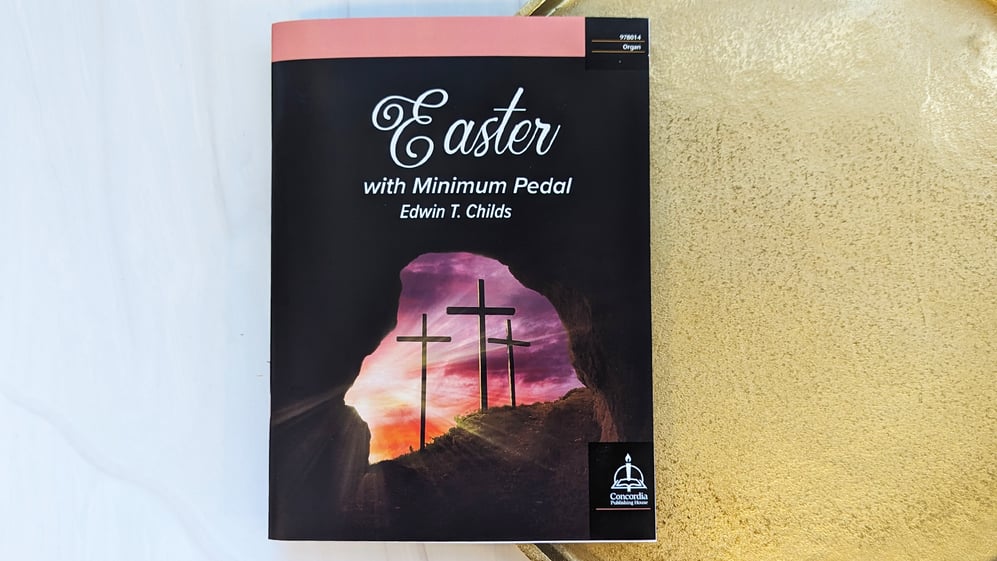Edwin T. Childs adds to his series of settings for minimal pedal, providing a collection of hymn tunes for the Easter season. Composed as a single stanza, these preludes are suitable as hymn introductions or service music. Easter with Minimum Pedal will appeal to organists who have limited pedal abilities or seasoned organists who need something in a pinch.
Music for Minimal Pedal
Easter with Minimum Pedal is Edwin T. Childs’s fourth installment in his collection of organ preludes for minimal pedal. It comes on the heels of his collections for Advent, Christmas, and Lent. As the title suggests, pedal lines are present—but undemanding—in these preludes.
This genre of minimal-pedal organ music is fitting for organists—beginners or otherwise—with keyboard skills who are looking to improve their pedal skills with attainable and tasteful music for church services. These pieces may serve as an excellent teaching and learning tool for organists just beginning to incorporate their feet into their playing or for organists who rely on playing primarily on the manuals.
The presence of a pedal line in organ music is significant; most pedal lines supply a foundational bass sound and feel by utilizing pipes from the 16-foot ranks (marked 16' on the organ stops).
Using Easter with Minimum Pedal
Aside from being a useful resource for pedal technique, Easter for Minimum Pedal provides a variety of avenues for use during the church service. The preludes in the collection feature each hymn tune’s melody once from the first to the final bar.
One of the ways organists could use these preludes is by employing them as hymn introductions. Musicians will find an array of compositional styles and recommendations for registration throughout the collection. Some of the pieces are stately and urgent, and others are reflective and subdued. The diversity of style, registration, and mood offers another option for a hymn introduction aside from simply playing the four-part setting in the hymnal to introduce a hymn.
In addition to hymn introductions, these preludes can be used as preservice, in-service, or postlude music. For example, an organist could locate the hymn tunes in this collection that his or her congregation is singing on a particular Sunday in Easter and play the setting of each tune as a short series of preservice selections to put the melodies of that day’s hymns in the congregation’s ears.
Or, an organist could utilize these preludes as brief interludes between distribution hymns. The congregation would sing a hymn, and rather than moving straight into introducing the next hymn to be sung, the organist would play a brief prelude on the hymn that was just sung as a way of recapping what the congregation had sung and heard. Of course, volume and timing should be considered.
The Contents of Easter with Minimum Pedal
In addition to its usefulness in incorporating pedal lines and its versatility in the church service, Easter with Minimum Pedal should be an often-utilized resource throughout the Easter season. Twenty-five Easter tunes are included in this volume, so organists can use the collection from Easter Day through the seventh week of Easter. All twenty-five tunes appear in Lutheran Service Book.
Some of the hymn tunes are associated closely with Easter Day itself, such as EASTER HYMN (LSB 457 “Jesus Christ Is Risen Today”) and CHRIST LAG IN TODESBANDEN (LSB 458 “Christ Jesus Lay in Death’s Strong Bands”), but others are fitting throughout the fifty-day season.
For example, the hymn “O Sons and Daughters of the King” is set to two tunes: GELOBT SEI GOTT (LSB 470) and O FILII ET FILIAE (LSB 471). This hymn is most appropriate on the Second Sunday of Easter, when the appointed Gospel reading tells of Jesus appearing to His disciples a week after His resurrection in John 20 and Thomas’s confession “My Lord and my God!” (John 20:28) after he had placed his hands in Jesus’ wounds, reversing his disbelief.
Scripture: ESV®.
Copyright © Concordia Publishing House.
Play these organ settings this Easter by ordering the collection below.













.jpg?width=50&height=50&name=IMG_20220621_160541_456%20(1).jpg)
